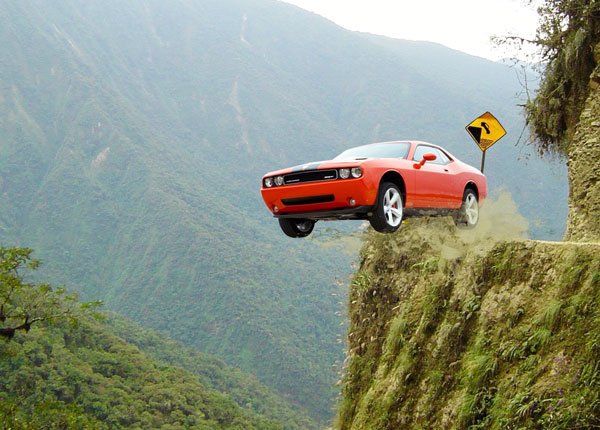
Skid Control for Driving Safety: Prevention and Recovery Steering Techniques
Updated Dec. 14, 2020Skidding can occur on roads that are slippery due to rain, mud, snow or ice. It may also be caused by sudden turns, lane changes or hard braking at a speed that causes wheels to lock. If you lose your grips on the road’s surface and begin to skid, stay calm – do not overreact or slam on the brakes. Use the skid prevention and recovery information outlined in this module to help you regain control of the vehicle.
Preventing skids
Let's discuss the tactics and techniques you can employ to avoid skidding in the first place. There is a great deal you can do to minimize the risk of skidding, most of which comes down to driving in a controlled and conscientious manner.
- 1

Be aware of conditions that may cause skidding, so that a slippery patch of the road does not take you by surprise.
Freezing and thawing temperatures can lead to particularly slippery driving conditions. - 2

Avoid sudden changes in speed and direction.
- 3

Know that shaded areas become slippery sooner and remain that way for longer, as compared to parts of the road that get sunlight.
- 4

Practice stops and skid recovery in a safe area on private property, before driving on ice or a snow-packed road with other traffic.
This should be done at low speeds with caution; it is not an excuse to drive recklessly. - 5

Slow down well in advance of the point at which you wish to stop when driving on ice or snow.
- 6

Do not apply brakes with so much force and speed that the wheels lock.
If this happens, release the brakes and pump them gently to slow the vehicle.
Avoiding a skid with anti-lock brakes (ABS)
When you need to stop suddenly, the way you should brake to avoid a skid depends on whether your vehicle is equipped with an anti-lock braking system. Knowing how to apply your brakes properly in an emergency could one day save your life.
If your vehicle does not have ABS, you should apply and release the brakes repeatedly. Pumping the brakes like this will slow your vehicle down without locking the wheels so that you can remain in control and avoid a skid. This is also known as “threshold” or “squeeze” braking.
Drivers of vehicles with ABS should maintain a firm and continuous pressure on the brake. This will not lock your wheels or cause a skid. Do not pump the brake as you would with a standard brake vehicle. You may hear a grinding noise and feel a vibration in your foot when braking hard with ABS, though this is perfectly normal.
Recovering from a skid
There are two main types of skidс: front-wheel skids and rear-wheel skids. Rear-wheel skids are generally caused by a loss of rear-wheel traction due to a slippery road surface, resulting in an oversteering situation on a corner, bend or lane change.
Front-wheel skids happen when the driver of a front-wheel drive vehicle hits the brake or accelerator hard. When front wheels skid, you will not be able to steer the vehicle. Despite this, front-wheel skids are considered less hazardous and easier to correct than rear-wheel skids, as there is no risk of the vehicle skidding in the opposite direction when trying to regain control.
Essentially, the same technique is used to correct both front-wheel and rear-wheel skids. The main point to take away is that you must steer in the direction you need the front part of the vehicle to go, to straighten up. For instance, if the rear tires are skidding out to the left, you should steer your front tires to the left too. Follow these skid correction guidelines:
- Do not panic
- Do not slam on the brakes.
- Gently steer in the direction you need your front wheels to go. During a rear-wheel skid, this will be in the same direction as the skid.
- Do not oversteer or overcorrect by steering too vigorously out of the skid.
- Slow the vehicle to regain control, either by lightly pumping the brake or applying consistent pressure if your car uses anti-lock braking.
Keep in mind that some front-wheel drive and four-wheel drive vehicles may need gentle acceleration to correct a skid. You should be able to find this information in your owner’s manual.
If you cannot steer out of the skid and regain control of your vehicle, consider slowing the skid by steering onto a different surface – if it is safe to do so. This may include edging into a bank of snow or a row of bushes. Alternatively, you may simply be able to correct the skid by positioning a wheel on a dry piece of road.
Acceleration skids
You may experience an acceleration skid if your drive wheels lose grip on the road. Correct this type of skid by gently easing your foot off the gas pedal and re-aligning the front wheels as the vehicle regains traction and begins to straighten up.
Locked wheel skids
Locked wheel skids occur when traveling at a high speed and braking too forcefully or abruptly. To unlock the wheels and slow down, you must take your foot off the brake pedal. Follow the brake application guidance above to correct the skid, based on whether your vehicle uses an anti-lock braking system.
If you are lightly pumping the brakes because your vehicle does not use ABS, shift down a gear or put your vehicle in neutral to slow down. Once the vehicle has slowed considerably, you might try using your emergency or parking brake to come to a complete stop.
Driving off the pavement
Devastating collisions can occur when a skid is so powerful that it takes you off the pavement. If you cannot regain control of your vehicle before this happens, follow the advice outlined here and do your best not to panic.
- Grip your steering wheel tightly with both hands.
- Steer directly ahead.
- Do your best to stay on the shoulder.
- Ease off the accelerator and gently apply the brake, releasing it if your wheels begin to lock.




